Heatwaves, water, shade and Dan Pearson's garden
This week there's a garden update on water and my clover lawn but most of the post to devoted to my visit to Hillside, Dan Pearson’s remarkable garden near Bath.
🌱 I'm Sally Morgan, an organic gardener and botanist who loves to experiment. Here you can read about matters relating to climate change, sustainability, organic gardening, growing veg and biodiversity, helping you to become a
climate savvy gardener 🌱☀️🌧️❄️🌡️
Note - this is a long email (lots of photos) so the post may be truncated and you will have to click through to read the rest on Substack
Its still hot and very little rain has fallen in the last three months. Most of the north of the country seems to have had a few deluges, but down in the South West, we are still waiting for a really good downpour. The kitchen garden is water hungry but fortunately the dipping pond still has plenty of water. The beds get a couple of buckets of water once or twice a week which seems to be enough. Much of the rest of the garden has been left to its own devices, apart from new plants and those looking to be water-stressed, and its looking quite good considering!
High temperatures continue across the southern UK and much of Europe, with daily readings reaching reaching the 30s°C. But it’s not just Europe that’s feeling the heat. Much of the eastern United States, from South Carolina all the way north to Maine, is also experiencing extreme temperatures. Several major cities have declared heat emergencies, with temperatures soaring above 37°C (100°F), levels not seen at this time of year in more than 30 years. In New York’s Central Park, the temperature reached 96°F, equalling a record set all the way back in 1888. We often associate extreme heat with places like Death Valley, but last weekend, parts of Kansas were actually hotter than Death Valley itself.
The heat is being driven by a ridge of high pressure - a heat dome - which has stalled over the central and eastern U.S., trapping hot air and causing intense daytime heat, with very little cooling at night.
This heat wave has been intensified by exceptionally high humidity, making it feel even hotter. This is a result of the surface waters of the Gulf of Mexico being at record-high temperatures. These unusually warm Gulf waters allow the air above to hold more moisture, and this humid air is being pulled north under the heat dome. This not only raises daytime temperatures but also increases the nighttime ‘dew point’ to tropical levels, making it feel oppressively hot around the clock.
While these regions are no strangers to summer heat, such extreme conditions in June are highly unusual. Infrastructure is not prepared for this early-season intensity. For gardeners, this means plants are being exposed to high temperatures at a time of year when they’re not yet acclimatised and this increases the likelihood of stress and damage, something that I will come to later in this post.
My clover lawn – an update
Last year, I sowed two clover lawns and I’ve been really pleased with how they’ve turned out. They’ve grown well, been carpeted in flowers, and buzzed with bees. Best of all, they’ve coped brilliantly with the hot, dry weather. The plants have formed a nice, dense mat, and the soil underneath remains remarkably moist. The only downside? The edges have become a bit of a haven for slugs!
Now that the first flush of flowers is over, I’ve given the larger lawn a cut to encourage regrowth and another flush of flowers. And the bonus, barrel loads of clippings which I’ve laid out to dry in the sun, and once they’re ready, I’ll use them as mulch around my squash plants.
Dan Pearson’s Hillside Garden
Last week, I spent a day at Hillside on a visit organised by Garden Masterclass. This is the first part of my report, part two will follow next week.
As our bus wound its way down the narrow, steep lane to the garden, we caught glimpses of the picturesque valley below. It was clear we were in for a special day.


Dan Pearson and his partner Huw Morgan moved to this valley, just north of Bath, in 2010. They bought a run-down 20-acre former smallholding, used partly as a market garden and partly for raising beef cattle. Today, most of the land is managed with wildlife in mind: restored meadows, a large wildlife pond, dense hedgerows, coppice, a ‘blossom wood’, and orchards. Alongside these, there’s a large perennial garden, a kitchen garden, and more recently, a new sand garden.
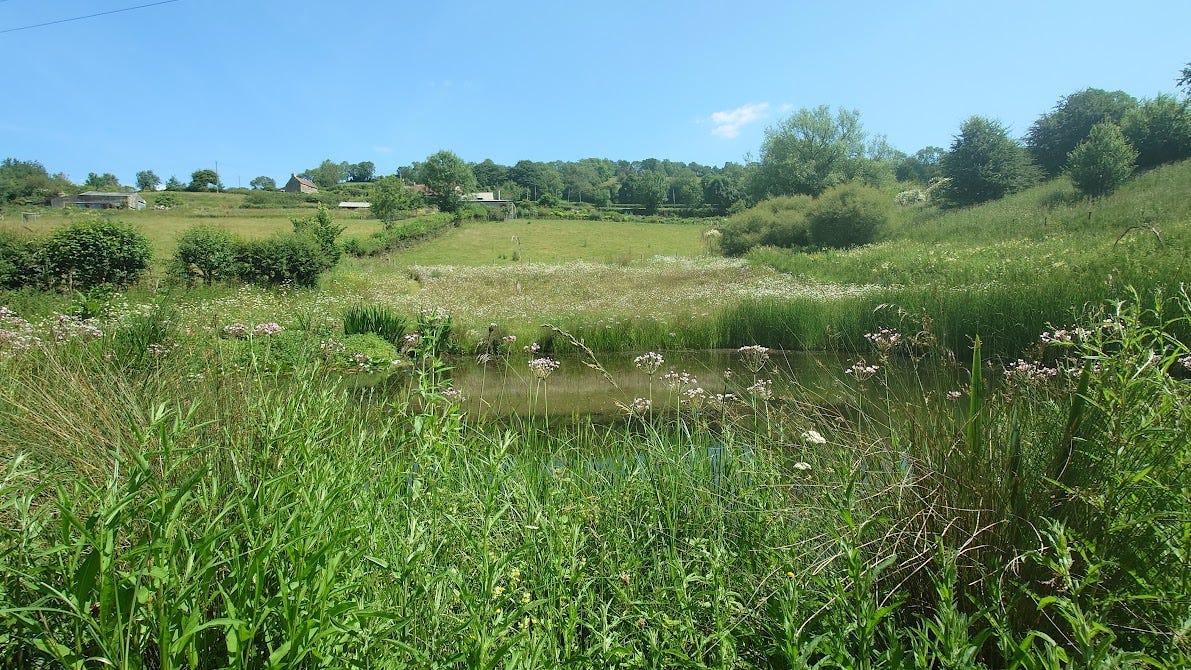
For the first few years, very little was done in terms of landscaping. Instead, Dan and Huw used the time to understand the site, thinking carefully about how the new garden would sit within the wider landscape. They wanted to create a seamless connection between the cultivated and the wild, using irregular, flowing boundaries rather than hedges, so the eye could move naturally between the two.
The sloping site required significant early terraforming. Soil was moved from above the house to create a new terrace alongside it, resulting in two level plateaus, so the gardens now run along a contour.
The first garden to be developed was the perennial garden, begun around 10 years ago and planted in phases. Set on a slope, the soil becomes increasingly dry and shallow as you move uphill, requiring a thoughtful approach to planting and the addition of shade. Care went into designing the transition zone between the cultivated garden and the surrounding landscape, the so-called ‘outer ripple’. This area needed to feel calm and ‘semi-transparent’, allowing the garden’s textures to blend with the meadow beyond. In contrast, the ‘inner ripple’, closer to the house, is more ornamental, with richer colours and more complexity to draw and hold the eye.
The overall aesthetic is naturalistic and rhythmic, not overly blocky, and with no single plant dominating the scene.
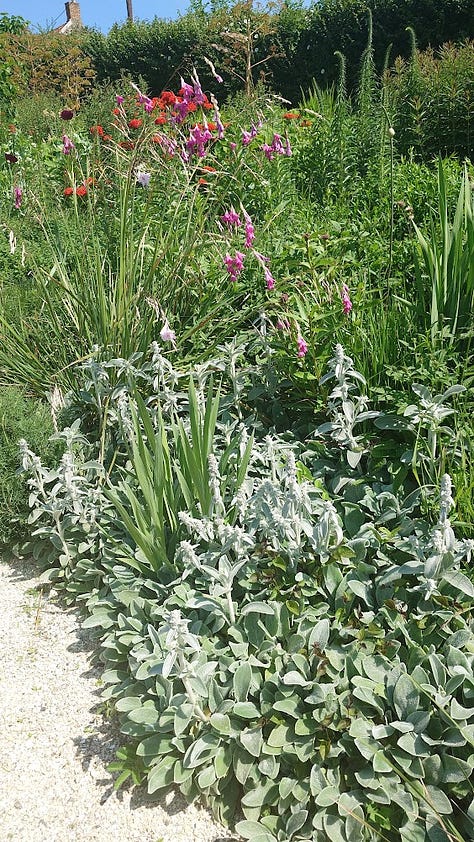



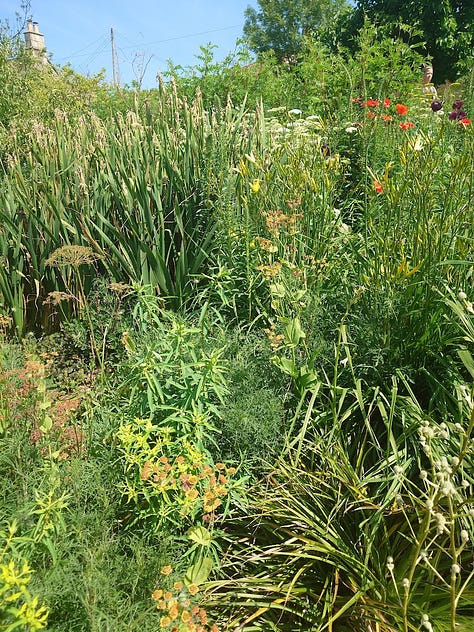
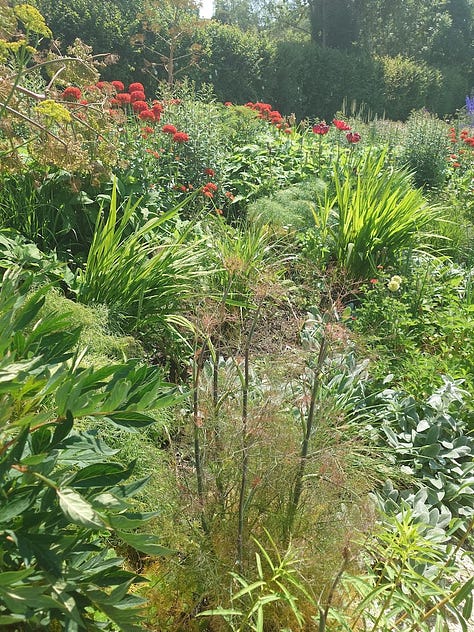
There was plenty of discussion as you can imagine so I have pulled out a few of the points that interested me:
Creating shade Climate change is making itself felt, but in ways we weren’t prepared for perhaps. The unusually high temperatures that we are experiencing at the moment so early in summer can create a lot of stress for those plants that are not ready for such heat. It could be that they have a lot of young growth or the shade that they rely on in high summer hasn’t formed yet, leaving them exposed. This is true of the shade loving Cimicifuga rubifolia that burns so easily in the heat. This and other species may not feature in gardens so frequently in the future. Hence, its important to create some shady niches. Dan is planting more shrubs and small trees within the garden and as they become established and cast their dappled shade, they will create conditions that will result in a shift in the composition of the understorey, causing some plants to disappear and others to move in.
Shade is often overlooked and its something I have been working on in my garden for some time, particularly in the kitchen garden where I look to include taller plants, such as sweet corn and broad beans, tripods of Malabar spinach, bean and peas etc in every bed to cast shade over those crops that are more likely to be stressed, such as spinach and squash.
Observing and editing Dan stressed the importance of making notes, mental or physical, to remind him in winter about any adjustments that need to be made. Editing is a constant job too. Initially, Dan trialled a wide range of sanguisorba, but he has edited the range down as they can get large or collapse so they are moved to create space. For example, Sanguisorba Cangshan Cranberry along with the meadow rue Thalictrum Elin were found to be quite thug like and pushed out less competitive plants, so some had to be moved, along with plants that failed to thrive. Another edit includes the switch grass Panicum virgatum Cloud Nine which was used to divide some of the planting, but Dan found it slow to reach its full potential and its been replaced with Miscanthus, while Lythrum salicaria has been replaced with Lythrum virgatum.
Mulching and a circular system The perennial plants are allowed to stand through winter and then in February the old growth is taken down, chipped and put back on the beds, a truly circular system. He finds this chipped mix holds moisture and encourages ground beetles.
Water harvesting I was delighted to see lots of water harvesting around the garden, and there were a number of recycled galvanised steel water tanks. There is also a very large granite trough, once used for tanning leather, that stores a lot of water, as well as creating a feature in the terrace just beyond the outdoor kitchen.



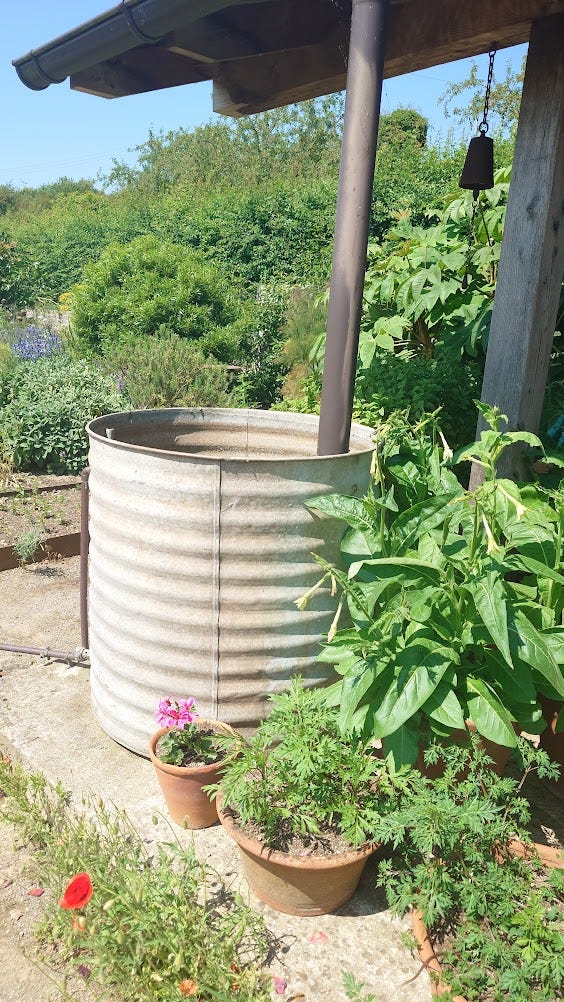
Lots of recycled water tanks were placed beside the buildings to collecting water from guttering
To be continued ……………..
You’ll have to wait until next week to read about the new Sand Garden at Hillbrook and the very new and experimental garden created by James Hitchmough at his home in Somerset.
Happy gardening
PS If you enjoyed reading this post, please click the ‘like’ button at the bottom, it really helps make my posts more visible on the SubStack app. Thank you xxx
Talks in 2025
1 July Sherston, near Malmesbury
9 July Bramzero, Calne
21 July Bride Valley near Dorchester
1 September Wootton Bassett
2 September Marshfield
4 September Dilton
18-20 September I will be at Yeo Valley on 18 and 19 Sept. Do come along. There is a huge line up of speakers, Yeo Valley Organic Garden Festival
2 October Ringwood
9 October Seavington
10 October Box Garden Club near Chippenham
11-12 October Bury St Edmunds Literary Festival I am teaming up with Becky Searle (IG sowmuchmore) to give a talk and run a workshop on Boosting biodiversity in the garden. Come along and join us! Programme here
13 October Rode, nr Frome








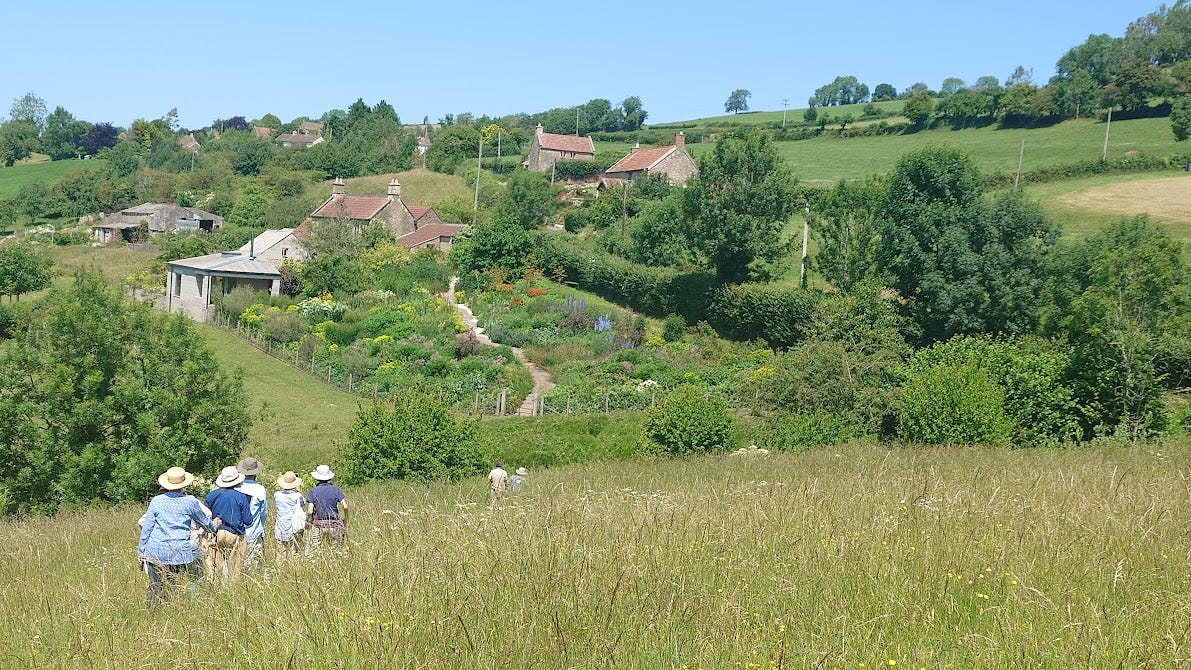
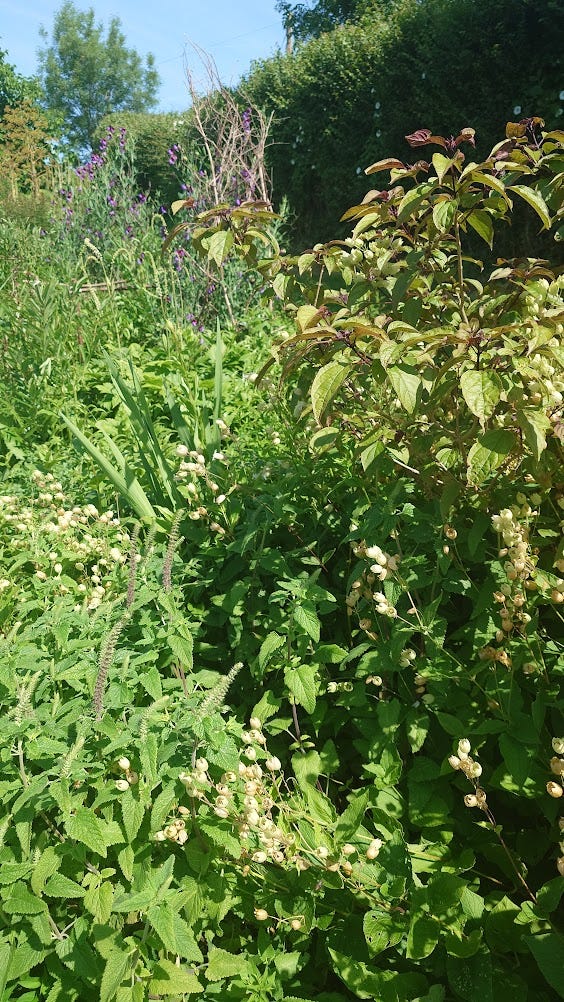

Thanks for this Sally - it's also interesting how much temperatures are varying across the country. While it was 33 degrees in London earlier this week it was only 18 here in Newcastle - quite a difference. Quick question: why do you need the clover to dry out before mulching your courgettes with it?
The sudden rising and falling off temperatures this spring has been so strange in the region around Philadelphia, PA, US. It was 100F/37C for days, and today, it was 75F/24C. That sort of change comes with wind and storms - more garden damage. The fluctuating temperatures makes it difficult for gardeners to harden off to the heat as well. My body, with lots of water and an extremely large straw hat to make shade around me, will get used to working in 90-100F heat. But it's been too much, too soon, after a cool spring, and now it's cool again. On collecting water in the UK, are mosquitoes not a problem there? Too cool most of the time for them to make a home?